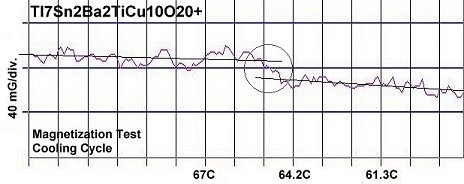
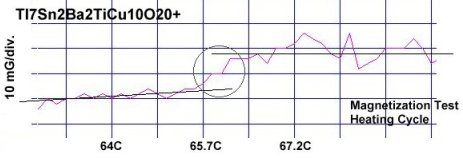


Superconductors.ORG herein reports the world superconductivity record has been increased to near 65 Celsius (338K, 149F) by reformulating the 53C superconductor announced in November 2013. In the reformulation silicon is replaced with titanium changing the chemical formula to Tl7Sn2Ba2TiCu10O20+.
Due to such an extraordinarily high transition temperature (Tc), two separate pellets were synthesized a week apart and both tested extensively. The plots at page top show two examples of the Meissner transition which appeared consistently near 65C in both pellets.1 The transitions are approximately 12 to 16 milli-Gauss in amplitude.
The reason for the improved Tc appears to be the higher dielectric constant (relative permittivity) in the region between the "Heavy" and "Light" layers of the H212 structure (shown lower left). Since titanium is heavier than silicon, the planar weight ratio along the C2 axis is lower, which should have reduced Tc. However, this reduction is more than offset by the higher dielectric constant (K) of titanium dioxide versus silicon dioxide. TiO2 has a reported Kappa of 86-173, while SiO2 only has a Kappa of 4.
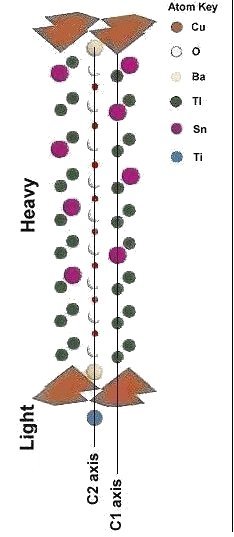
|
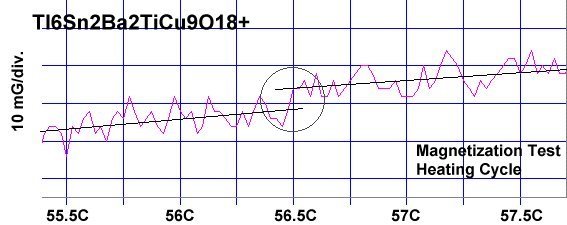
This 65C discovery comes after finding a link between dielectric constant and Tc in December 2013 while experimenting with tantalum oxide. That copper oxide ceramic produced a Tc almost 50 degrees higher than it should have. This new world record also comes after 56C superconductivity was found in the compound Tl6Sn2Ba2TiCu9O18+ (see above plot). Together, the 56C and 65C discoveries represent the 14th and 15th ceramics found to superconduct above room temperature.2 All of the plots on this page exhibit a low signal-to-noise ratio due to a low volume fraction of superconductive material and a high thermal noise level inherent to these temperatures. The straight lines in the magnetization plots approximate the average of the data points, skewing apart at Tc. UPDATE: Three months after the original discovery, supplemental resistance tests were performed on the same material, again showing unambiguous transitions near 65 Celsius (see below). Direct resistance measurements were performed instead of 4-point, due to the brittleness of the pellet. Note that the non-superconductive bulk has a negative temperature coefficient, sloping the opposite direction as the transitions. |
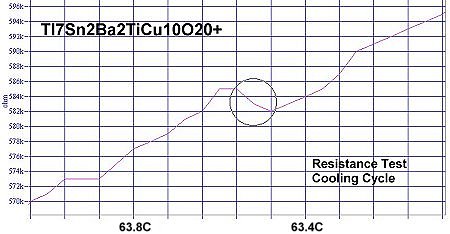
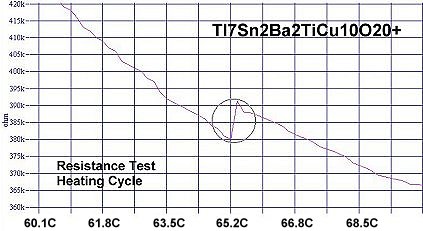
These discoveries lend additional support to the theory that superconductivity in the layered cuprates originates in the oxygen layers where the planar weight ratio is highest. This is because titanium only comes in contact with the oxygen layer between the heavy and light regions.
This compound was synthesized using the layer cake method, as shown below. The pellet had over 100 interference layers. And, even using this layering technique, the volume fraction is low, requiring very sensitive test equipment.
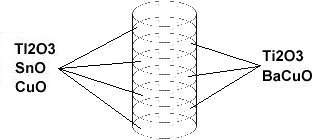
Stoichiometric ratios of the below chemicals were used for the ODD layers:
Tl2O3 99.99% (Alfa Aesar) 7.67 grains...and the below ratios for the EVEN layers.
Ti2O3 99.8% (Alfa Aesar) .86 grainsThe chemical precursors were pelletized at 60,000 PSI and sintered for 56 hours at 860C. The pellet was then annealed for 10+ hours at 500C in flowing O2. Temperature was determined using an Omega type "T" thermocouple and precision OP77 DC amplifier. The magnetometer employed twin Honeywell SS94A1F Hall-effect sensors with a tandem sensitivity of 50 mv/Gauss.
RESEARCH NOTE: The copper-oxides are strongly hygroscopic. All tests should be performed immediately after annealing.
RE-PUBLICATION NOTICE: Elsevier Publishing, dba Elsevier Science, as well as Morris Communications, both print and broadcast divisions, are specifically prohibited from re-publishing any part of this news story.
E. Joe Eck
© 2014 Superconductors.ORG
All rights reserved.
1. Testing temperatures are believed accurate within +/- 0.50 degrees C.
2. Materials 5, 6, 8, 11, 12 and 16 are proprietary formulations not yet published, pending patent application.
 BACK to "News" page at Superconductors.ORG
BACK to "News" page at Superconductors.ORG